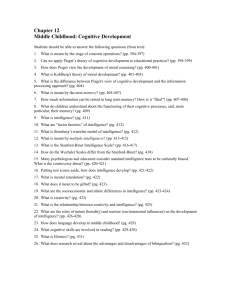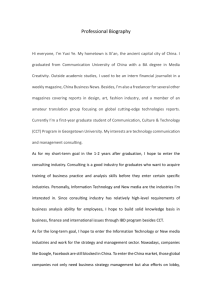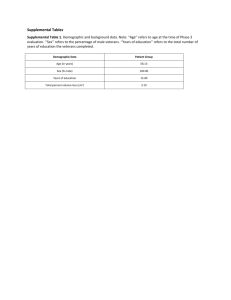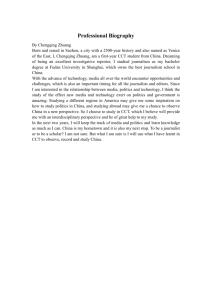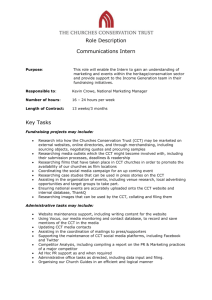On the Impact of Computer Cognitive Training on Cognition:
advertisement
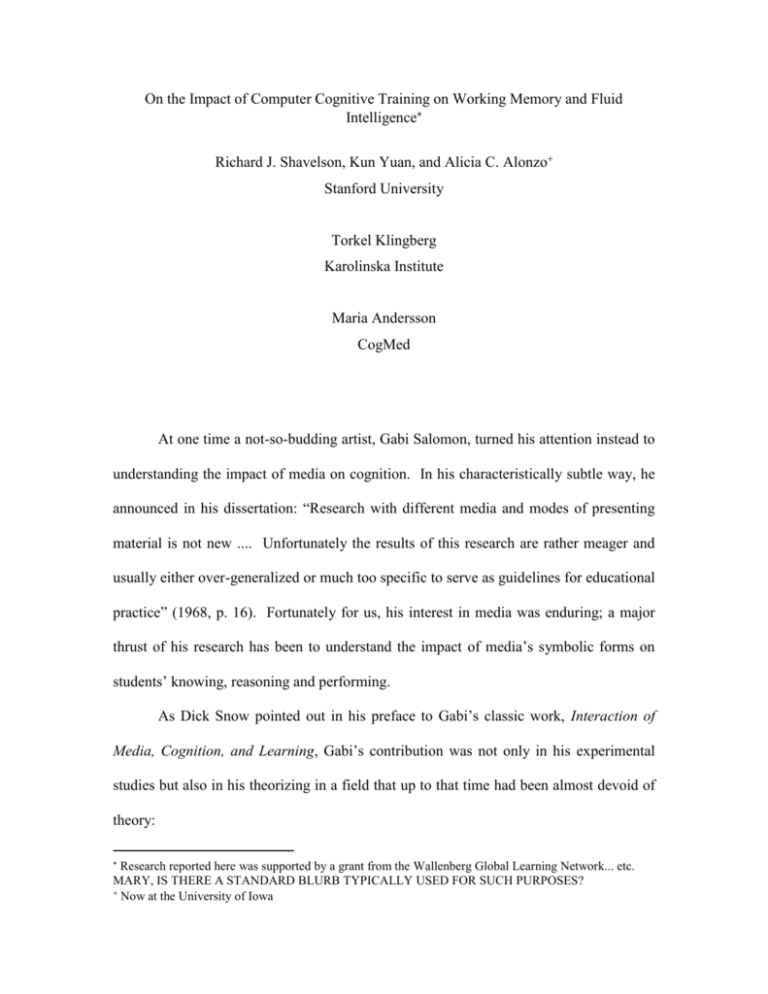
On the Impact of Computer Cognitive Training on Working Memory and Fluid Intelligence Richard J. Shavelson, Kun Yuan, and Alicia C. Alonzo Stanford University Torkel Klingberg Karolinska Institute Maria Andersson CogMed At one time a not-so-budding artist, Gabi Salomon, turned his attention instead to understanding the impact of media on cognition. In his characteristically subtle way, he announced in his dissertation: “Research with different media and modes of presenting material is not new .... Unfortunately the results of this research are rather meager and usually either over-generalized or much too specific to serve as guidelines for educational practice” (1968, p. 16). Fortunately for us, his interest in media was enduring; a major thrust of his research has been to understand the impact of media’s symbolic forms on students’ knowing, reasoning and performing. As Dick Snow pointed out in his preface to Gabi’s classic work, Interaction of Media, Cognition, and Learning, Gabi’s contribution was not only in his experimental studies but also in his theorizing in a field that up to that time had been almost devoid of theory: Research reported here was supported by a grant from the Wallenberg Global Learning Network... etc. MARY, IS THERE A STANDARD BLURB TYPICALLY USED FOR SUCH PURPOSES? Now at the University of Iowa Impact of CCT on WM Draft Shavelson, Yuan, & Alonzo Salomon has sought a deep-structure theory … based in an understanding of the characteristics of symbol systems. He has sought further to show that these characteristics can shape not only knowledge acquisition and organization through a particular medium but also the differential development of cognitive skills (Snow in Salomon, 1979, p. x). Gabi recognized that media as part of the environment might affect mental growth. But he argued that until there was experimental evidence that media’s symbol systems could be made to affect cognition, the search for environmental impact might prove elusive. To this end, his theorizing led to ingenious experiments in which he varied “filmic coding elements” to see their impact on mental skills of skilled and unskilled learners. In one experiment using a Breughel painting, he created three filmic conditions and a control group: (1) modeling (conjectured to be helpful for unskilled learners), (2) short-circuiting (alternating between the full painting and a detail back to full then to another detail—conjecturing little facilitative effect), (3) activation (three slides of the painting--conjecturing helpful for skillful learners), and (4) control (no treatment). His findings were generally consistent with his theoretical conjectures (Salomon, 1974). In another study, he varied two coding elements—close-up/long shot and the zoom-in/out—hypothesizing that these two forms might affect cognitive skills differentially; they did (Salomon & Cohen, 1977). All of this work was done with television and film. Just think what Gabi might do with computers. In 1986, Gabi and one of us waxed euphoric about the potential: “For the first time, a genuinely ‘thinking’ interacting technology, the computer, has become 2 Impact of CCT on WM Draft Shavelson, Yuan, & Alonzo readily available to education …. [for] extending and shaping the mind” (Shavelson & Salomon, 1986, p. 4). We went on: The pedagogical promise of the new information technology is boundless if we can master the technology. This promise lies partly in mapping the three attributes of the technology—information, symbol systems, and activities— onto their mental correlates: knowledge structures, internal modes of symbolic representation, and cognitive operations, respectively (p. 4). Now we “fast-forward” (a coding element that probably can be found in his work) to our work today on computer cognitive training of memory and executive control functions. We use the symbol-systems and other functions of today’s computers in an attempt to expand cognition, namely human working memory capacity and fluid intelligence. As we shall see, Gabi’s theory—that of capitalizing on coding elements—now over 25 years old, still has lessons for “next steps” in our work. But we are getting ahead of the story. We now turn to our research following along the path Gabi set. Working Memory and Fluid Intelligence Defining Working Memory Working memory (WM) is responsible for temporarily maintaining and manipulating information during cognitive activity (Baddeley, 2002). It is closely related to a wide range of high-level cognitive abilities such as reasoning, problem-solving, and learning (Kyllonen & Christal, 1990), and thus is related to academic achievement across domains (Abu-Rabia, 2003; Daneman & Tardif, 1987; De Smedt, Ghesquiere, & Verschaffel, 2004; Gathercole, Pickering, Knight, & Stegmann, 2004). 3 Impact of CCT on WM Draft Shavelson, Yuan, & Alonzo Early research in this area (Ebbinghaus, 1885; James, 1890; Miller, 1956) focused on the temporary storage of information, similar to what Atkinson and Shriffrin (1968) called short-term memory (STM). However, STM could not adequately describe the kind of temporary memory that complex cognitive tasks require (Shah & Miyake, 1999) and STM came to be seen as one component of a larger system known as WM. Most researchers agree that WM includes multiple subsystems working together to activate task-related information, maintain activation, and manipulate information during cognitive activity (Miyake & Shah, 1999). WM is generally considered to serve two functions: storage and executive control. The storage function of WM is typically characterized as working memory capacity (WMC), which refers to the amount of information activated and retained during cognitive functioning. Baddeley (2002) proposed a WM model in which separate components are responsible for acoustic/verbal and visuospatial information (such as shapes, locations, or movements). The existence of phonological and visuospatial stores in WM is widely accepted (e.g., Barnard, 1999; Oberauer, Süß, Schulze, Wilhelm, and Wittmann, 2000) and there is evidence for storage of additional types of information, such as tactile and kinesthetic (Kieras, Meyer, Mueller, and Seymour, 1999). The executive control function is more controversial. While researchers agree that WM includes this function (Baddeley, 2002; Baddeley & Hitch, 1974; Barnard, 1999; Cowan, 1999; Engle, Kane, & Tuholski, 1999; Lovett, Reder, & Lebiere, 1999), they disagree as to how it is realized. The argument centers around the question of whether the executive control function is carried out consciously, by a separate component of WM, or whether it is merely the result of interactions between other 4 Impact of CCT on WM Draft Shavelson, Yuan, & Alonzo subsystems of WM. Baddeley’s model included a separate central executive, responsible for allocating attention and coordinating activities between other WM components. Engle, Kane, and Tuholski (1999), Schneider (1999), and Kieras et al. (1999) support his notion of a separate and conscious executive control component in WM. However, other researchers argue that other subsystems of WM and their interactions can account for the executive control function (e.g., Barnard, 1999; Lovett et al., 1999). Both Barnard and Lovett et al. successfully predicted performance on WM tasks, using their models of WM without a separate executive control function. For our study’s purposes, it is sufficient to note that WM consists of both a shortterm memory function and an executive control function. Computer cognitive training might affect either or both. Measuring Working Memory The lack of consensus about working memory itself is reflected in the variety of WM measures. Simple memory span tasks can be thought to measure the storage component of WM. These tasks present subjects with a series of stimuli, usually letters, words, digits, shapes, or positions, and require them to recall those stimuli in the same or reverse order as they were presented. These tasks may be divided into those measuring phonological storage (e.g., Ackerman, Beier, & Boyle, 2002; Kail & Hall, 2001; Masson & Miller, 1983; Oberauer, Süß, Schulze, Wilhelm, & Wittmann, 2000; Rosen & Engle, 1997) and visuospatial storage (Cornoldi & Venville, 2003; Corsi, 1972; Della Sala, Gray, Baddeley, Allamano, & Wilson, 1999; Vecchi & Richardson, 2001). Although these simple memory span tasks are still used in current studies of WM, most researchers view them as tapping primarily the storage component of WM and not the control 5 Impact of CCT on WM Draft Shavelson, Yuan, & Alonzo function of WM (Conway, Cowan, Bunting, Therriault, & Minkoff, 2002; Engle, Tuholski, Laughlin, & Conway, 1999). However, some researchers believe backward simple memory span tasks require more of the control function of WM than forward simple memory span tasks do (e.g., Oberauer et al., 2000). To better reflect the dual components of WM (storage and attention control), Daneman and colleagues (Daneman & Carpenter, 1980; Daneman & Tardif, 1987) followed Baddeley and Hitch’s (1974) definition of WM to develop a series of dual tasks. These tasks required simultaneous processing and storage of information. For example, the processing task for reading-span dual tasks is to read a series of sentences while the memory task is to recall the last word in each sentence. A number of similar tasks have been devised, varying the content and difficulty of the processing and memory tasks (e.g., Cantor, Engle, & Hamilton, 1991; Daneman & Tardif, 1987; Engle, Nations, & Cantor, 1990; Hambrick & Engle, 2001; Turner & Engle, 1989). Daneman and Tardif (1987) asserted that the dual tasks measure both the storage and the control function of WM and viewed them as a more valid WM measurement tool than simple memory span tasks. Studies have found dual tasks to have higher and more consistent correlations with higher-order cognitive abilities than do simple memory span tasks (Engle, Tuholski, Laughlin, & Conway, 1999; Unsworth & Engle, 2006). For our study, then, we include measures that tap predominantly short-term memory (memory-span tasks) and measures that tap both short-term memory and the executive control function (dual tasks). Including both types of measures enables us to track the impact of computer cognitive training on these two functions of WM. Relationship between WM and fluid intelligence 6 Impact of CCT on WM Draft Shavelson, Yuan, & Alonzo WMC has been found to be correlated with fluid intelligence or the ability to reason abstractly and adapt to complex or novel situations (Conway, et al., 2002; Engle, et al., 1999; Kane, Hambrick, & Conway, 2005; Kyllonen & Christal, 1990); at issue, however, is whether WM is isomorphic with fluid intelligence. Kyllonen and Christal (1990) found the correlation between WM and fluid intelligence to be 0.82 to 0.88 and argued that these two constructs were the same. However, correlations reported in other studies were lower, ranging from 0.20 to 0.85 (Ackerman, Beier, & Boyle, 2005; Beier & Ackerman, 2004; Jurden, 1995; Kane, et al., 2005; Oberauer, Schulze, Wilhelm, & Süß, 2005). Differences in how WM was measured provide one possible reason for the different correlations reported. Kyllonen and Christal’s WM measures were more complicated than typical dual tasks, looking more like problem solving tasks. Conway et al. (2002) contended that WM might be the most important among many factors that influence fluid intelligence. Klingberg et al. (2005) used a computerized cognitive training (CCT) program called RoboMemo (Cogmed Cognitive Medical Systems AB, Stockholm, Sweden) to train WM in a randomized controlled experiment. Their results showed that children with attention-deficit/hyperactivity disorder (ADHD) significantly increased WMC, improved fluid intelligence, and reduced ADHD symptoms through the training. However, because children in Klinberg et al.’s study represented a narrow, special population and the study was implemented in a clinical setting, the results cannot be extended to a larger population or school settings. Our study attempted to examine the effects of CCT on the WM and fluid intelligence of typical middle school students. Purpose and Conjectures 7 Impact of CCT on WM Draft Shavelson, Yuan, & Alonzo The purpose of our research was to determine whether CCT could improve middle school students’ WM and if so, what, if any, influence the training had on their intelligence. We conjectured that CCT would improve students’ WM, especially shortterm memory, and that changes in WM would lead to an increase in fluid intelligence. Methods Design and Participants A randomized controlled experiment was carried out at a middle school in northern California in 2006. Thirty-seven students (13 girls and 24 boys) who chose to participate in the study (and forgo an elective class) were given tests of WM and fluid intelligence and then randomly assigned to CCT or a control condition (Figure 1). In both conditions, students received five weeks of training and took the same set of tests afterward. The average age of the participants was 13.5 years old (SD = .70). Eight students were diagnosed as having attention deficit disorder (ADD), attention deficit/hyperactivity disorder (ADHD), or a learning disability (LD). Analyses comparing regular and diagnosed students did not find any significant differences on our measures. Therefore, these eight students were included in the analysis with regular students. Exp. Worked on WM training for 30-40 (N=18) minutes a day, 5 days a week, 5 weeks. Pretest (N=51) Randomly Assigned Ctr. Worked on computerized science (N=19) lessons and low WM training for 30-40 minutes a day, 5 days a week, 5 weeks. Figure 1. Research design. Training 8 Posttest (N=37) Impact of CCT on WM Draft Shavelson, Yuan, & Alonzo CCT was conducted in a computer lab at the middle school (see Figure 2) for five days a week, 25 days in total. Notice that students sat individually at tables facing the wall and wore headphones as they worked on their laptops. Our intent was to prevent distractions so that students could fully concentrate on their work. Figure 2. Training setting. Students in the experimental group worked on 10 different WM exercises included in the CCT program RoboMemo® (2005, Cogmed Cognitive Medical Systems AB, Stockholm, Sweden). The CCT included three letter span tasks, two backward digit span tasks, and five visuo-spatial WM tasks, including static visuo-spatial tasks (one 2D visuo-spatial task, one 3D visuo-spatial task), and three dynamic visuo-spatial tasks, in which students recall the positions of rotated or moving objects (Klingberg et al., 2005; Olesen, Westerberg, & Klingberg, 2004). The program continuously adjusted the difficulty level of each exercise to match the student’s performance. Students completed 10-15 trials on eight exercises each day for a total of 115 WM trials per day. Training time averaged about 30 - 40 minutes per day, depending on the exercise set and the student’s performance level. Students in the control group worked on computerized science lessons and a placebo version of the WM training program—MegaMemo (2005, Cogmed Cognitive 9 Impact of CCT on WM Draft Shavelson, Yuan, & Alonzo Medical Systems AB, Stockholm, Sweden). Two types of training sessions were alternated throughout the 25 days of training: Students watched science videos from www.unitedstreaming.com (Discovery channel programs or similar instructional videos) for 15-30 minutes and answered relevant questions on one day. On alternating days, they conducted internet research related to the previous day’s video and worked on the same WM training exercises as experimental group students did in RoboMemo, but the difficulty of their exercises remained on a low level instead of adjusting to their performance. Six trained coaches were randomly assigned to experiment and control group students. They were present in the computer lab during the training, watching over students while they worked, keeping a training log, encouraging students, and providing feedback once a week based on students’ performance during training. Figure 3 shows an example of an experimental group student’s performance record which coaches used to provide feedback. During the feedback meeting with control group students, coaches discussed their answers on the science questions and their performance in MegaMemo. 10 Impact of CCT on WM Draft Shavelson, Yuan, & Alonzo Figure 3. Performance record coaches used to give feedback. Measures Five measures were used as indicators of students’ WM and fluid intelligence. (See Table 1 for brief descriptions.) The internal consistency reliability coefficients for these measures ranged from 0.76 ~ 0.90 (see Table 2). This finding indicates that these tests provided reliable measures of the corresponding psychological constructs. We examined the dimensionality of the WM scores with an exploratory factor analysis using primary axis factoring and promax rotation with Kaiser normalization rotation. We found 11 Impact of CCT on WM Draft Shavelson, Yuan, & Alonzo two factors: an attention control and memory storage factor (dual tasks), and a storage only factor—numerical WM, and visuospatial WM. The two factor solution accounted for 81% of the total variance. The correlation between the two factors was 0.52. These findings are consistent with the corresponding construct definitions and research literature. Table 1 Summary of Measures Used in the Study Measure Source Span-board Task: Simple Span Task Cogmed Cognitive Medical Systems AB, Sweden (Klingberg et al., 2005) Forward, Backward, Total Digit Span: Educational Testing Service (Ekstrom et al., 1976) Forward, Backward, Total Operation Span Attention and Working Memory Lab, Georgia Institute of Technology (Conway et al., 2005; Unsworth et al., 2005) Reading Span Attention and Working Memory Lab, Georgia Institute of Technology (Conway et al., 2005) Raven’s Progressive Matrices Oxford Psychologists Press (Raven, 1998) Dual Task Fluid Intelligence 12 Impact of CCT on WM Draft Shavelson, Yuan, & Alonzo Results and Discussion Among the WM measures, the two dual tasks correlated most highly with each other (0.72 and 0.74 at pre- and posttest, respectively).. The correlations between Digit Span and the dual task measures were higher than those between Span-board and the dual tasks at both pre- and posttest. In addition, the correlation between simple memory span and the dual tasks increased over the training. WM scores correlated significantly with fluid intelligence (Raven) at both preand posttest (Table 2; reliabilities on main diagonal). Reading Span showed the highest correlation with fluid intelligence. Table 2. Correlation Matrix with Reliabilities on the Main Diagonal Measure Pretest Note: 1. 2. Span-Board Total Digit Span Total Operation Span Reading Span Raven Span-Board Total .82 .44** .35* .19 .45** Posttest Digit Span Operation Total Span .30 .47** .89 .56* .49** .76 .44** .72** .37* .35** Reading Span .47** .58* .74** .79 .57** Raven .40* .36* .38* .46** .82 *Correlation is significant at .05 level (2-tailed); **Correlation is significant at .01 level (2-tailed); Diagonal cells display test reliability. The reliabilities given are generally the average Cronbach α on pre- and posttest. For Span-Board, we report the test-retest reliability for the control group. On average, the experimental group students increased more on WM and fluid intelligence than did control group students (see Figure 4). We ran a series of analyses of covariance to test these observed differences statistically, using the posttest as the dependent variable, the corresponding pretest as the covariate, and training group as the independent variable. We found that experimental group students’ average improvement was significantly greater than that of control group students on Span-board and Digit 13 Impact of CCT on WM Draft Shavelson, Yuan, & Alonzo Span. However the observed differences on Operation Span and Reading Span were not statistically significant, although they were in the predicted direction. Standardized Gain = (Posttest-Pretest)/Standard Deviation 1.20 1.00 0.80 Treatment Control 0.60 0.40 0.20 0.00 Span-Board Total Digit Span Total Operation Span Reading Span Raven Outcome Measures Figure 4. Comparison of standardized change on all outcome measures. Since both Span-board and Digit Span mainly measure the ability to remember information for a short period of time, the significant improvement of the experimental group students on these two scales showed that CCT effectively improved students’ short-term memory. As indicated in prior literature, Operation Span, and Reading Span tapped both the ability to remember information and the ability to control different cognitive tasks at the same time. Thus, experimental group students’ improvement on both dual tasks indicated that either the training simply improved the memory portion of the dual tasks or that it also improved students’ control function in WM. Regardless the change in cognitive control was not as substantial as that in memory capacity. 14 Impact of CCT on WM Draft Shavelson, Yuan, & Alonzo On average, the experimental group students improved more on the measure of fluid intelligence than did the control group students; however, this difference was not statistically significant. One possible explanation is that the improvement in WM did not transfer immediately to fluid intelligence. It might take some time for the improvement in fluid intelligence to become evident. Another possible explanation focuses on the impact of WM on fluid intelligence for regular students. Klingberg et al. (2005) reported significant improvement in fluid intelligence for children with ADHD using the cognitive training program. For children with ADHD, limited WM constrains their informationprocessing ability, which significantly restricts their fluid intelligence. Therefore, improvement in WM will substantially enhance their fluid intelligence. WM may not pose the same bottleneck for regular students as for children with ADHD. For regular students (including the 8 diagnosed students), their WM may be sufficient to process information such that the same improvement in WM will not lead to a similar significant increase in fluid intelligence as that for children with ADHD. Conclusion Computer Cognitive Training effectively improved experimental students’ memory capacity and attention control, with a greater change in the former than in the latter, compared to control students’ performance. While the difference between experimental and control groups was statistically significant for the memory capacity measures, the change in scores on the attention-control measures, although in the predicted direction, was not statistically significant. CCT also increased average scores on a measure of fluid intelligence although the difference was not statistically significant. 15 Impact of CCT on WM Draft Shavelson, Yuan, & Alonzo We conjectured a number of possible explanations for these findings. Paramount among them was the explanation that the CCT exercises focused on short-term memory to a greater extent than on cognitive control. This is not to say students could perform the exercises by relying upon memory alone as task difficulty increased; some cognitive control had to be involved. However, strategies for controlling attention and handling multiple pieces of information were not trained directly nor were they modeled by the symbol systems used in the CCT. CCT did not train strategies directly. Rather, students’ mental effort at the tasks was expected to lead to the evolution of personal strategies as task difficulty increased. This construction of strategies was thought to be a more effective approach than directly teaching such strategies. This is a theoretical conjecture that can and should be tested empirically. However, Gabi would have pointed out that the symbolic capacities of computers might have been used to model one or more cognitive strategies for handling information overload in WM. For example, the computer might simulate the chunking of a series of digits, words, or light sequences. Or it might highlight the relationship among a sequence of lights presented horizontally and then show what happens when the lights are rotated by 90 degrees. In both cases, these simulated cognitive strategies would be introduced and then faded out as student performance improved. Such use of symbols and representations with students’ associated actions would simulate the internal cognitive strategies that students might adopt to reduce task overload and improve their performance. Again, this conjecture could be tested experimentally. 16 Impact of CCT on WM Draft Shavelson, Yuan, & Alonzo Optimistically, if we are able to improve working memory, and correspondingly intelligence, in a manner that generalizes beyond the specific tasks trained, a wide range of students might be in a better position to learn from experiences in and out of school. Gabi’s theorizing about the impact of media on cognition suggests ways in which such generalization might be had. School tasks that involve multiple sequences of reasoning might become more accessible to students. Remembering information presented in class might become easier. And the capacity to produce complex arguments might be facilitated. There is some evidence that in special populations of students (ADHD), WM improvement has led to improvement in reading and mathematics. Perhaps this is possible as well for students more generally, especially those currently struggling to keep up in school. 17 Impact of CCT on WM Draft Shavelson, Yuan, & Alonzo References Abu-Rabia, S. (2003). The influence of working memory on reading and creative writing processes in a second language. Educational Psychology, 23, 209-222. Ackerman, P. L., Beier, M. E., & Boyle, M. O. (2002). Individual differences in working memory within a nomological network of cognitive and perceptual speed abilities. Journal of Experimental Psychology: General, 131, 567-589. Ackerman, P. L., Beier, M. E., & Boyle, M. O. (2005). Working memory and intelligence: The same or different constructs? Psychological Bulletin, 131, 30-60. Atkinson, R. C., & Shriffrin, R. M. (1968). Human memory: A proposed system and its control processes. In K. W. Spence & J. T. Spence (Ed.), The psychology of learning, remembering, and forgetting: Proceedings of the second conference. New York: New York Academy of Sciences. Baddeley, A. (2002). Is working memory still working? European Psychologist, 7, 85-97. Baddeley, A., & Hitch, G. (1974). Working memory. In G. H. Bower (Ed.), The psychology of learning and motivation (Vol. 8, pp. 47-89). New York: Academic Press. Barnard, P. (1999). Interacting cognitive subsystems: Modeling working memory phenomena within a multiprocessor architecture. In A. Miyake & P. Shah (Eds.), Models of Working Memory: Mechanisms of Active Maintenance and Executive Control (pp. 298-339). New York: Cambridge University Press. Beier, M. E., & Ackerman, P. L. (2004). A reappraisal of the relationship between span memory and intelligence via "best evidence synthesis". Intelligence, 32, 607-619. 18 Impact of CCT on WM Draft Shavelson, Yuan, & Alonzo Cantor, J., Engle, R. W., & Hamilton, G. (1991). Short-term memory, working memory, and verbal abilities: How do they relate? Intelligence, 15, 229-246. Conway, A. R., Cowan, N., Bunting, M. F., Therriault, D. J., & Minkoff, S. R. (2002). A latent variable analysis of working memory capacity, short-term memory capacity, processing speed, and general fluid intelligence. Intelligence, 30, 163-183. Conway, A. R. A., Kane, M., Bunting, M. F., Hambrick, D. Z., Wilhelm, O., & Engle, R. W. (2005). Working memory span tasks: A methodological review and user's guide. . Psychonomic Bulletin and Review, 12, 769-786. Cornoldi, C., & Venville, G. (2003). Visuo-spatial working memory and individual differences. New York: Psychology Press. Corsi, P. M. (1972). Human memory and the medial temporal region of the brain. Unpublished Doctoral dissertation, McGill University, Montreal. Cowan, N. (1999). An embedded-processes model of working memory. In A. Miyake & P. Shah (Ed.), Models of Working Memory: Mechanisms of Active Maintenance and Executive Control. New York: Cambridge University Press. Daneman, M., & Carpenter, P. A. (1980). Individual differences in working memory and reading. Journal of Verbal Learning and Verbal Behavior, 19, 450-466. Daneman, M., & Tardif, T. (1987). Working memory and reading skill re-examined. In M. Coltheart (Ed.), Attention and performance (Vol. 7, pp. 491-508). London: Erlbaum. De Smedt, B., Ghesquiere, P., & Verschaffel, L. (2004, April). Working memory and arithmetic abilities in seven and eleven year old children. Paper presented at the European Working Memory Symposium EQOMS II, Beaune, France. 19 Impact of CCT on WM Draft Shavelson, Yuan, & Alonzo Della Sala, S., Gray, C., Baddeley, A., Allamano, N., & Wilson, L. (1999). Pattern span: A tool for unwelding visuo-spatial memory. Neuropsychologia, 37, 1189-1199. Ebbinghaus, H. (1885). Über das Gedächtnis: Untersuchungen zur experimentellen Psychologie. Leipzig: Duncker & Humblot. Ekstrom, R. B., French, J. W., & Harman, H. H. (1976). Manual for kit of factor referenced cognitive tests. Princeton, NJ: Educational Testing Service. Engle, R. W., Kane, M. J., & Tuholski, S. W. (1999). Individual differences in working memory capacity and what they tell us about controlled attention, general fluid intelligence, and functions of the prefrontal cortex. In A. Miyake & P. Shah (Eds.), Models of Working Memory: Mechanisms of Active Maintenance and Executive Control (pp. 102-134). New York: Cambridge University Press. Engle, R. W., Nations, J. K., & Cantor, J. (1990). Is “working memory capacity” just another name for word knowledge? Journal of Educational Psychology, 82, 799-804. Engle, R. W., Tuholski, S. W., Laughlin, J. E., & Conway, A.R. (1999). Working memory, short-term memory, and general fluid intelligence: A latent-variable approach. Journal of Experimental Psychology: General, 128, 309-331. Gathercole, S. E., Pickering, S. J., Knight, C., & Stegmann, Z. (2004). Working memory skills and educational attainment: Evidence from national curriculum assessments at 7 and 14 years of age. Applied Cognitive Psychology, 18, 1-16. Hambrick, D. Z., & Engle, R. W. (2001). Effects of domain knowledge, working memory capacity, and age on cognitive performance: An investigation of the knowledge-ispower hypothesis. Cognitive Psychology, 44, 339-387. 20 Impact of CCT on WM Draft Shavelson, Yuan, & Alonzo James, W. (1890). The principles of psychology. Retrieved March 12, 2005, from http://psychclassics.yorku.ca/James/Principles/index.htm. Jurden, F. H. (1995). Individual differences in working memory and complex cognition. Journal of Educational Psychology, 87, 93-102. Kail, R., & Hall, L. K. (2001). Distinguishing short-term memory from working memory. Memory & Cognition, 29, 1-9. Kane, M., Hambrick, D. Z., & Conway, A. R. (2005). Working memory capacity and fluid intelligence are strongly related constructs: Comment on Ackerman, Beier, and Boyle (2005). Psychological Bulletin, 131, 66-71. Kieras, D. E., Meyer, D. E., Mueller, S., & Seymour, T. (1999). Insights into working memory from the perspective of the EPIC architecture for modeling skilled perceptual-motor and cognitive human performance. In A. Miyake & P. Shah (Ed.), Models of Working Memory: Mechanisms of Active Maintenance and Executive Control (pp. 183-223). New York: Cambridge University Press. Klingberg, T., Fernell, E., Olesen, P. J., Johnson, M., Gustafsson, P., Dahlstrom, K., et al. (2005). Computerized training of working memory in children with ADHD: A randomized, controlled trial. Journal of American Academic Child Adolescent Psychiatry, 44, 177-186. Kyllonen, P. C. (2002). g: Knowledge, speed, strategies, or working memory capacity? A systems perspective. In R. J. Sternberg & E. L. Gigorenko (Ed.), The general factor of intelligence: How general is it? (pp. 415-445). Mahwah, NJ: Erlbaum. Kyllonen, P. C., & Christal, R. E. (1990). Reasoning ability is (little more than) workingmemory capacity?! Intelligence, 14, 389-433. 21 Impact of CCT on WM Draft Shavelson, Yuan, & Alonzo Lovett, M. C., Reder, L. M., & Lebiere, C. (1999). Modeling working memory in a unified architecture: An ACT-R perspective. In A. Miyake & P. Shah (Ed.), Models of Working Memory: Mechanisms of Active Maintenance and Executive Control (pp. 135-182). New York: Cambridge University Press. Masson, M. E., & Miller, J. A. (1983). Working memory and individual differences in comprehension and memory for text. Journal of Educational Psychology, 75, 314318. Miller, G. A. (1956). The magical number seven, plus or minus two: Some limits on our capacity for processing information. Psychological Review, 63, 81-97. Miyake, A., & Shah, P. (Ed.). (1999). Models of Working Memory: Mechanisms of Active Maintenance and Executive Control. New York: Cambridge University Press. Oberauer, K., Schulze, R., Wilhelm, O., & Süß, H. M. (2005). Working memory and intelligence - their correlation and their relation: Comment on Ackerman, Beier, and Boyle (2005). Psychological Bulletin, 131, 61-65. Oberauer, K., Süß, H.-M., Schulze, R., Wilhelm, O., & Wittmann, W. W. (2000). Working memory capacity - facets of a cognitive ability construct. Personality and Individual Differences, 29, 1017-1045. Raven, J. C. (1998). Raven Standard Progressive Matrices Plus. Oxford: Oxford Psychologists Press. Rosen, V. M., & Engle, R. W. (1997). Forward and backward serial recall. Intelligence, 25, 37-47. 22 Impact of CCT on WM Draft Shavelson, Yuan, & Alonzo Salomon, G. (1968). Interaction of communication-medium and two procedures of training for subjective response uncertainty of teachers. Unpublished doctoral dissertation, Stanford University, Stanford, CA. Salomon, G. (1979). Interaction of media, cognition, and learning. San Francisco, CA: Jossey-Bass. Salomon, G. (1974). Internalization of filmic schematic operations in interacton with learners’ aptitudes. Journal of Educational Psychology, 26, 138-145. Salomon, G., & Cohen, A.A. (1977). Television formats, mastery of mental skills, and the acquisition of knowledge. Journal of Educational Psychology, 69, 612-619. Schneider, W. (1999). Working memory in a multilevel hybrid connectionist control architecture (CAP2). In A. Miyake & P. Shah (Ed.), Models of Working Memory: Mechanisms of Active Maintenance and Executive Control (pp. 340-374). New York: Cambridge University Press. Shah, P., & Miyake, A. (1999). Models of working memory: An introduction. In P. Shah & A. Miyake (Ed.), Models of working memory: Mechanisms of Active Maintenance and Executive Control. Cambridge: Cambridge University Press. Shavelson, R.J., & Salomon, G. (1986). Information technology: Too and teacher of the mind. Educational Researcher, 14, 4. Turner, M. L., & Engle, R. W. (1989). Is working memory task dependent? Journal of Memory and Language, 28, 127-154. Unsworth, N., & Engle, R. W. (2006). Simple and complex memory spans and their relation to fluid abilities: Evidence from list-length effects. Journal of Memory and Language, 54, 68-80. 23 Impact of CCT on WM Draft Shavelson, Yuan, & Alonzo Unsworth, N., Heitz, R. P., Schrock, J. C., & Engle, R. W. (2005). An automated version of the operation span task. Behavior Research Methods, 37, 498-505. Vecchi, T., & Richardson, J. T. (2001). Measures of visuospatial short-term memory: The Knox Cube Imitation Test and the Corsi Blocks Test compared. Brain and Cognition, 46, 291-295. 24



